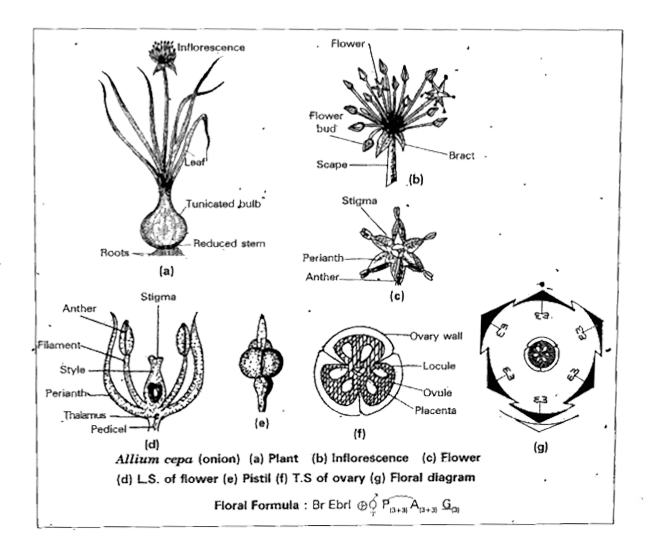Give an account of the family Liliaceae. Solution in Telugu
Vegetative characters :
Habitat : Plants may be mesophytes (Allium, Lilium) as well as xerophytes (Asparagus, Ruscus, Aloe) are found in this family.
Habit : Plants are mostly perennial herbs. In some plants like Dracanena, Yucca, Aloe etc., Shrubs or trees are also found. Few are climbers (Glorioa, Smilax).
Root system : It is adventitious root system. In Asparagus fasciculated tuberous roots are present.
Stem : In majority of the species the stem is underground and perennial. It may be a bulb (Scilla, Allium, Lilium), a Rhizome (Gloriosa) or a corm (Colchicum). The aerial stem is weak in tendril climbers like Gloriosa, Smilax etc. Stem is aerial and shows anomalous secondary growth in Dracaena and Yucca. Branches are modified into cladophyllus (Asperagus Ruscus).
Leaf : The leaves may be radical (Alliium, Lilium) or cauline (Smilax, Gloriosa). Alternat phyllotaxy is common. Leaves are petiolate, simple stipulate or exstipulate. Venation is usually parallel, but exceptionally reticulate in Smilax. Leaves are succulent in yucca and Aloe.
Floral Characters :
Inflorescence : Solitary cyme or umbel or raceme.
Flower : The flowers are usually bracteate, ebracteolate, pedicellate, actinomorphic, complete. Bisexual, homochlamydeous, trimerous and hypogynous. Exceptionally flowers are unisexual in Smilax and Ruscus.
Perianth : It consists of six tepals arranged in two whorls of three each. The odd tepal is anterior in position. The aestivation is valvate.
Androecium : Stamens are six, arranged into whrols of three each. Epiphyllous (Asparagus). Anthers are dithecous, basifixed, introrse and dehiscence is longitudinal.
Gynoecium : It is tricarpellary and syncarpous. The oary is superior and trilocular with several anatropous ovules on axile placentation. The style is terminal and stigma is trified and capitate.
Floral Formula : 
Pollination : It is of entomophilous type. Flowers may be protandrous (Allium) or protogynous (Colchicum) in Glorisa flowers show herkogamy.
Fruit : It may be a berry (Asparagus, Smilax) or loculicidal capsule (Lilium) or septicidal capsule (Gloriosa).
Seed : It is endospermic with straight or sometimes curved embryo and monocotyledonous. Polyembryony is seen in some memebrs (Allium).

Topper's Solved these Questions
- BOOK - VIKRAM PUBLICATION ( ANDHRA PUBLICATION)CHAPTER - TAXONOMY OF ANGIOSPERMS EXERCISE - IMPORTANT QUESTIONS10videos
TAXONOMY OF ANGIOSPERMS
- BOOK - VIKRAM PUBLICATION ( ANDHRA PUBLICATION)CHAPTER - TAXONOMY OF ANGIOSPERMS EXERCISE - SHORT ANSWER TYPE QUSTIONS7videos
TAXONOMY OF ANGIOSPERMS
- BOOK - VIKRAM PUBLICATION ( ANDHRA PUBLICATION)CHAPTER - STRUCTURAL ORGANISATION IN ANIMALS EXERCISE - Important Question24videos
STRUCTURAL ORGANISATION IN ANIMALS
- BOOK - VIKRAM PUBLICATION ( ANDHRA PUBLICATION)CHAPTER - THE LIVING WORLD EXERCISE - TEXTUAL EXERCISES9videos
THE LIVING WORLD
Similar Questions
What is Omega Taxonomy ?
02:46View SolutionWrite a brief note on semi technical description of a typical flowering plant.
01:59View SolutionWhat is tissue level of organisation among animals? Which metazoans do exhibit this organisation?
01:22View SolutionSome of the properties of tissues are not constituents of their cells. Give two examples to support the statement.
04:52View SolutionFamiliar examples of family Liliaceae are
01:07View SolutionAn example of liliaceae family is
33:44View SolutionFruit of liliaceae family is
02:45View SolutionGive a scientific description of family Liliaceae. Mention the economic importance.
View SolutionOrnamental belonging to family Liliaceae are
51:56View SolutionFamily - Liliaceae
01:01:45View Solutionलिलिएसी कुल का पुष्प होता है
01:10:44View SolutionThe plant of Liliaceae family as medicine
01:33:00View SolutionFamilies OF angiosperm Liliaceae-lily family
02:28View Solutionfamily solanaceae, family liliaceae.
02:03View SolutionFamily Solanceae || Family Liliaceae || Family Brassicaceae
03:25View Solution

